
One of Casa Sauza’s agave fields in Jalisco.
The history of the Sauza family and its tequila distilleries are deeply intertwined with the history of Jalisco and tequila. Not only were the Sauza's among the oldest families involved in the production of tequila, but they have also been responsible for many innovations that have shaped the modern tequila industry.
At the beginning of the 18th century, Tequila was a remote village in the lowlands of Jalisco in the shadow of its namesake volcano. The village had a local reputation for its mezcal, dubbed "vino mezcal” or “vino tequila."
Over the course of the 18th century the mezcal trade steadily grew. A road connecting Tequila with the port of San Blas, just north of the city of Puerto Vallarta , afforded access to other markets. Vino tequila found a ready market as far afield as sophisticated Mexico City.
Stills were primitive. There was little consistency in production methods or the raw materials, the agave and other fermentable plants, on which the distillation was based. Tequila producers competed locally with distillers of aguardiente, a spirit distilled from fermented sugar cane juice, coconut wine producers, as well as a broad range of fermented native beverages including pulque—fermented agave sap.
By the mid-18th century, vino tequila was more popular among Jalisco’s inhabitants than the native pulque. The production of vino tequila had moved from haciendas, where small stills had been as ubiquitous as bread ovens, to larger, specialized distillation plants called tavernas. The tavernas or taverns where the 18th century's version of brew pubs, where vino tequila was both made and consumed.
During the day tavernas would also send donkeys with small barrels of vino tequila strapped on either side to supply laborers at work sites. A tradition that has been preserved, although not the actual activity, at the Herradura distillery and its tequila carrying donkey Paco.
In 1740, Jose Antonio de Cuervo, along with a business partner know only by his surname Malaquisa, began to produce vino tequila at the Taberna La Chorrea. By 1750, they were reportedly shipping over 20,000 liters of vino mezcal yearly to neighboring Guadalajara. In 1758, the Spanish monarch, Ferdinand VI granted the two partners a large property on the outskirts of Tequila called La Cofradia de las Animas from which to harvest agave.
At the time, Jalisco was part of Nueva Galicia, an autonomous kingdom in the Viceroyalty of New Spain. The region that would one day come to define an important part of the spirit and culture of Mexico was, during this period, independent of Spanish authorities in Mexico City. Nueva Galicia had its own flag and seal, its own governor, appointed directly by the Spanish crown, and its own capital in Guadalajara.
Nueva Galicia would become the present day Mexican states of Jalisco, Nayarit, Zacatecas's, Colima and Aguascalientes—the heart of today's tequila producing zone. Its legacy of independence would characterize both the spirit of its tequila industry and its often-strained relationship with the central government in Mexico City.
Don Matias Angel de la Mita Padilla, a local priest, politician and historian who chronicled the early history of Nueva Galicia, noted that by the 1750’s, control of the production of vino tequila and coconut wine had already become a monopoly controlled by a few local families. From the very beginning, tequila was a big business that would define the economy and social hierarchy of the region.
The boom, as has so often been the case in tequila’s tumultuous history, proved short lived. In 1785, Charles III of Spain banned the local production of wines and spirits, including pulque and vino mezcal, in Spain's colonies to promote exports of similar Spanish products. The ban was eventually lifted in 1795, after Charles IV ascended to the Spanish throne, and distilleries could again be licensed.
By 1800, there were already 24 haciendas farming agave to produce mezcal. Twelve around the village of Tequila and another 12 around the village of Amatitán in the highlands. What specific varieties were being grown is not known, but they would have included the blue agave, then called chinos azul (Blue Chinese) and agave largo (long agave), a species characterized by extremely long leaves.
In 1805, a local entrepreneur named Jose Maria Castaneda built the La Antigua Cruz distillery in Tequila. The distillery would be owned by two others before being purchased by Don Cenobio Sauza in 1873. This was the beginning of what would became the Sauza tequila dynasty.
The first half of the 19th century was a boom period for vino mezcal. Mexico's war of independence from Spain, 1810-1821, brought a reduction in imports of Spanish wine and spirits and a renewed interest in indigenous Mexican beverages. Mezcal wine had been distributed to Mexican soldiers during the war of independence, many of whom retained their liking for it when they returned home.
On the other hand, Jalisco and its distillers lost a lot of their former independence when the former Spanish viceroy of Nueva Galicia was incorporated into the new United Mexican States. Other states and municipalities began to impose taxes on vino mezcal crossing their borders. The new government in Mexico City also tried to impose its authority on the region.
By now, the fame of vino mezcal had begun to be noticed by foreigners as well. In 1821, J.C. Beltran, an Italian visitor in Jalisco, noted that "the tequila maguey produces a high-quality liquor that is called mezcal wine."
Three years later, an English visitor, W. H. Hardy, observed that "this small maguey plant is fermented and produces a whiskey, which is distilled into a much stronger spirit called chinguerite." Chinguerite was a local fiery spirit that was made from either agave or sugar cane in the 18th century.
Several decades later, in the first printed reference to a tequila terroir, the French writer Ernest de Vigneaux noted that the village of "Tequila lends its name to the mezcal liquor in the same way that Cognac does to the liquors of France."
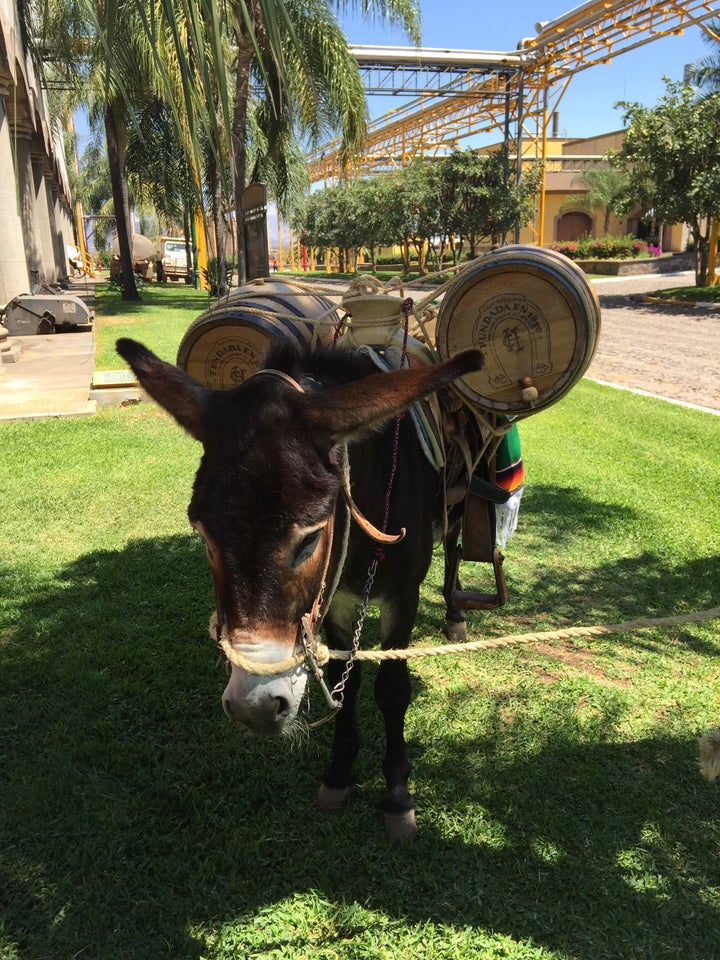
Paco, Herradura’s tequila carrying donkey.
In 1858, Cenobio Sauza (1842-1909), a native of Jalisco, travelled to Tequila to visit a cousin. Sauza found employment in the tequila distillery of Jose Antonio Cuervo, eventually holding a variety of administrative roles in the Cuervo distilleries. At some point, he also began to distribute tequila.
In 1870, he leased the "La Gallardeña" Distillery then owned by Lazaro Gallardo, a member of another prominent Tequila distilling family. The Gallardos, trace their roots in Jalisco back to the late 16th century.
After a lengthy absence from the industry, another branch of the Gallardo family, also with strong historical ties to the tequila industry, recently announced their return to tequila distillation in a joint venture with French spirits giant Moet Hennessey, a division of LVMH. Their new tequila, Volcan de mi Tierra was officially launched in May 2017 under the supervisor of noted Maestra de Tequila Ana Maria Romero Mena.
During the 19th century it was common to add the diminutive suffix "eña" to family names when naming a distillery. Vicente Albio Rojas, for example, changed the name of the Cuervo distillery to "La Rojeña." Now Cuervo’s flagship distillery, it still carries the same name. The Gallardo distillery was called La Gallardeña. Jesus Flores, who was linked to both the Sauza and Cuervo families, called his distillery La Floreña.
In 1873, Cenobio Sauza purchased the La Antigua Cruz distillery from Don Felix Lopez for 5,000 pesos. Sauza had formerly been the general manager of that operation. The distillery had been founded in 1805, and is, along with La Rojeña, founded in 1812, among the oldest operating tequila distilleries in Mexico.
Sauza changed the name to La Perseverancia, the name it still retains today. Eventually he also purchased the La Gallardeña distillery as well as a distillery, in 1889, from Vicente Orendain—another of the storied distillery families in Tequila.
The latter distillery had originally been purchased by Vicente Orendain from Jose Antonio Cuervo in the 1830’s. The Orendain family still operates a tequila distillery, Casa Orendain in Tequila, that dates to 1926.
Cenobio would go on to purchase 13 distilleries during his life, one of which would be retained by his family and is operated today by his great-great grandson Guillermo Sauza, and bottles tequila under the Los Abuelos (the grandparents) and Fortaleza brands.
Cenobio Sauza is credited by his namesake distillery with a number of significant milestones in the evolution of the tequila industry.
According to Casa Sauza, it was Cenobio that pioneered the use of steam in the hornos (ovens) to cook the agave.
Until about the 1850's, agave was cooked by roasting them in stone-lined pit overs. A fire would be built in the pit oven to heat the rocks that lined it. Once the fire had died down the agave would be placed in the fire pit and covered with brush and earth. The heat retained by the rocks would cook the agave. This is still the traditional way agaves intended for mezcal production are cooked.
It took about three cart loads of wood to cook the agave in a typical pit oven, roughly about four to five cords worth. As the tequila industry grew, the local forests were cut down and wood had to be brought from ever greater distances.
Sometime in mid-century, distillers gradually began to turn to stone ovens, typically lined with plaster or clay, to cook the agaves. The ovens were still wood fired, but less heat was wasted and less wood was needed.
This change marked the beginning of tequila's differentiation from mezcal. The agave cooked in wood fired ovens still retained some of the smoky character of mezcal, but far less so.
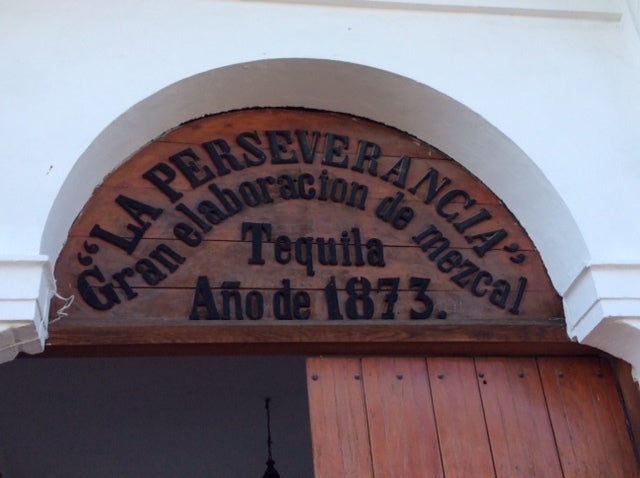
The entrance to the Sauza distillery, La Perseverancia
Cenobio Sauza began using steam heating in his ovens sometime in the 1890’s. A wood fired boiler was used to produce steam that was injected into the stone ovens to cook the agave. This marked the definitive break in the flavor profile between tequila and mezcal.
The product distilled from the agave cooked in steam heated stone ovens, however, was still referred to as mezcal, mezcal wine, mezcal whiskey or mezcal brandy.
Distillers in Tequila had successfully petitioned the Mexican government in 1870, for permission to call their mezcal, tequila. The term mezcal de tequila began to appear regularly on government tax receipts and shipping documents from that time on.
In 1873, both Sauza and Cuervo claim they made their first exports to the U.S. Although Cuervo claims its tequila was being shipped to California from the port of San Blas as early as 1852. Tax records indicate that small quantities of tequila de mezcal were also being exported to Europe. It's likely, however, that mezcal, including tequila de mezcal, had been filtering across the Mexican-American border for quite some time in small quantities during the 19th century.
In 1882, the Mexican railroad reached El Paso del Norte (El Paso-Juarez) and in 1884, a second rail line also reached the city. By the late 19th century, mezcal de tequila, usually called Mezcal brandy, was being exported regularly to the United States.
In 1893, a selection of Mezcal de Tequila submitted by Mexican producers won a total of seven awards in the brandy category at the Columbian Exposition at the Chicago World’s Fair. Their success spurred distillers to identify their distillate as Mezcal de Tequila and eventually as simply tequila.
According to the Sauza Distillery, it was also at this time that Cenobio Sauza began to promote the exclusive use of the blue agave for tequila distillation. The blue agave was then called Blue Chinese. It didn’t get its present name until 1902, when it was renamed Agave Tequiliana Weber Azul in honor of Frédéric Albert Weber, a German botanist who had come to Mexico in 1896 to study the country’s flora.
Sauza noticed that the blue agave variety grew faster than many of the other species being used to produce tequila. The blue agave was also higher in sugars, especially fructose. Its piñas could contain from 24 percent to as much as 40 percent sugar when fully ripe in the form of inulin a complex starch composed of linked fructose molecules. It was economics rather than a specific taste profile that dictated the use of blue agave in tequila production.
The 20th century brought a continuation of the boom and bust cycle that had characterized the tequila industry since its inception. Two world wars sharply curtailed the availability of European spirits and led to renewed interest in tequila, both in Mexico and in the U.S.
Prohibition in the U.S. also served to heighten interest in tequila and spurred visits to Mexican border towns. It was about this time that the margarita cocktail began to attract a following among Americans—a development that would become an important driver of tequila sales for the next half century.
Land reforms in the early part of the 20th century saw many of the large haciendas broken up and their holdings redistributed to small farmers. By 1929, there were only eight functioning tequila distilleries left in Mexico, down from 87 in 1910. The acreage devoted to agave cultivation in the meantime had dropped to one-third of its previous level.
Don Cenobio Sauza passed away in 1909. The distillery operation was taken over by his son Eladio Sauza. The younger Sauza had already been working in the company since 1903. He had run a Sauza Distillery in the village of Tecolotlán in Jalisco as well as a tequila distribution center in Mazatlán.
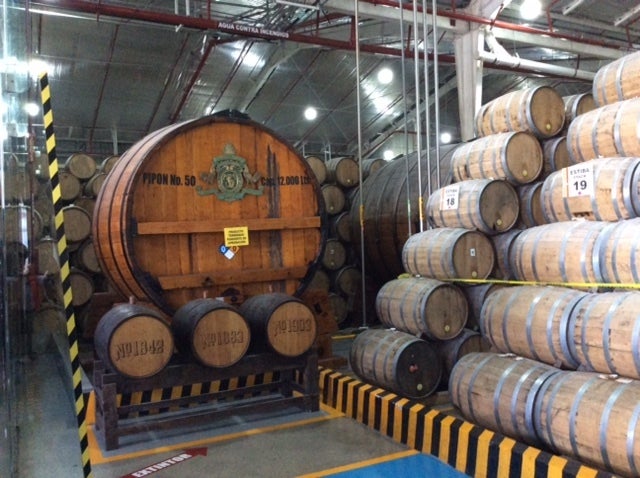
Maturation warehouse at Casa Sauza.
Under Eladio Sauza, the company opened sales offices in Monterrey and Mexico City, and set up an import company in Spain to facilitate European sales. By now, Sauza was firmly established as the second largest producer of tequila in Mexico, second only to Cuervo.
It was during Eladio's tenure that one of the quintessential traditions of tequila first became established. In 1930, the epidemic of Spanish Influenza reached northern Mexico. Local doctors recommended tequila to ward off the flu, prescribing it to be consumed with lime and salt. That was the origin of the lime and salt tequila shot that has fueled so many late night ragers.
It was also in the 1930’s that mixtos, tequila first made their appearance. While the tequila industry was technically regulated by the Mexican government, there was no legal definition of what constituted tequila until 1928.
Even then, that law did not mandate that only blue agave could be used in the production of tequila, although it did prohibit the use of non-agave sugars. That prohibition was short lived however.
During the 1930’s agave shortages, brought about in part as a result of land reforms, led to a revision of the 1928 law to permit the use of non-agave sugars although they had to remain below 50 percent of the total fermented sugars.
This exception was prohibited when the official standard for tequila was established in 1949. It specified that only 100 percent agave sugars could be used. This was changed to a maximum of 30 percent non-agave sugars in 1964, and was later increased to a maximum of 49 percent.
This was the origin of what came to be called mixtos. These tequilas were blander, better suited for cocktails and more readily accepted in the U.S.
Under current regulations, the term mixtos has been phased out. Tequilas that incorporate up to 49 percent non-agave sugars are called tequila, while tequilas that are 100 percent agave sugars from the blue agave are called 100% agave tequila.
As late as 1950, roughly half of the tequila produced in Mexico used agave sugars from different agave species than the blue agave.
It was only in 1978, when tequila was granted an Appellation of Origin, that its production was restricted to Agave Tequiliana Weber variety azul and the permitted production zone was specified to specific areas of the Mexican states of Nayarit, Jalisco, Michoacán, Tamaulipas and Guanajuato.
Eladio Sauza died in 1946, leaving control of the Sauza distillery operation to his oldest son, Francisco Javier Sauza. Francisco set about modernizing and expanding the distillery. He unveiled new upscale packaging and began to aggressively promote the sales of tequila in Europe and North America.
Under Francisco's tenure, Sauza launched the Hornitos brand in 1950, designed for a more upscale market, as well as the Sauza Conmemorativo, in 1963, to commemorate the 90th anniversary of the La Perseverancia distillery.
In 1973, to celebrate the 100th anniversary of the founding of the distillery, Sauza launched Tres Generaciones in honor of the three generations that had managed Sauza tequila since its creation: Don Cenobio, Don Eladio and Don Francisco Javier.
In 1988, the Spanish wine and spirits producer Pedro Domecq acquired Sauza. The two companies had previously been in a joint venture to distribute Sauza internationally. Pedro Domecq was in turn acquired by British spirits conglomerate Allied-Lyon.
The Sauza tequila company was eventually purchased by Fortune Brands and spun off with various other spirit brands to form Beam in 2011. Beam in turn was acquired by Japanese liquor giant Suntory to form Beam-Suntory—where Sauza now resides.
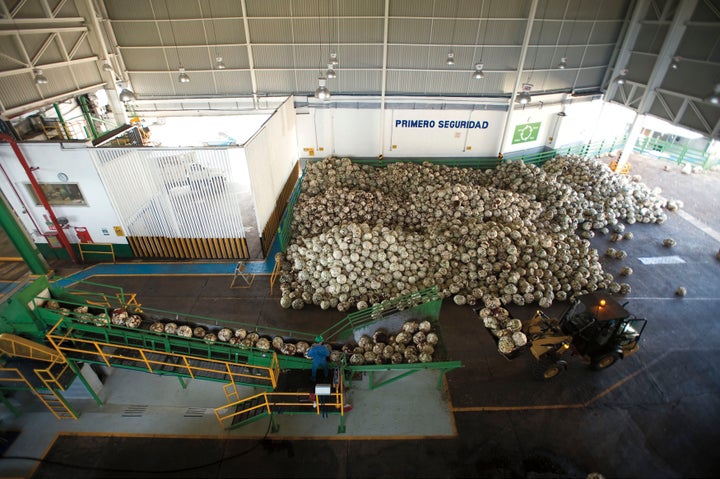
Piñas being fed into a shredder at the Sauza distillery.
Tequila Production at Sauza
The process of making tequila is relatively straightforward. The sugars in the blue agave piñas are extracted and fermented. Following fermentation, they are distilled and then, depending on the type of tequila being made, they may be aged for a period from several months to as much as five years.
The process, however, offers a range of options at each of the major steps and can result in marked differences in the aroma and flavor profile of the tequilas made.
In Sauza’s case tequila production differs significantly from many other tequila producers in the use of a diffuser to extract the sugars from the piñas.
The sugars in the agave piñas consist of a complex polysaccharide or starch called inulin. The inulin molecule is made up of a series of linked fructose molecules. To convert the inulin into a form where its component sugars can be metabolized by yeast, the piñas are heated to temperatures of between 90 and 100 degrees centigrade.
The heat causes the inulin to breakdown into its component sucrose molecules. The process mimics how the starches in potatoes or squashes are converted into a digestible form by heating in an oven. Once the piñas are cooked, the sugar laden juice can be squeezed out of them in any number of ways; from a traditional tahona milling wheel to high speed shredders and roller mill assemblies.
There is an alternative approach however to extracting the sugars from piñas using a process called a diffuser. In this case, piñas are shredded into very small pieces and are repeatedly doused with hot water as they move along a conveyer belt. The hot water dissolves the inulin in the piñas producing a starch rich liquid.
The entire process takes about four hours. The typical diffuser is about 100 feet long and about 20 feet wide. Unlike conventional baking in a traditional horno or an autoclave, diffusers can extract upwards of 99 percent of the usable sugars in the piñas.
Once extracted, the starch-rich liquid can be treated with an acid and then hydrolyzed to break down the inulin into its component fructose molecules.
Hydrolysis can be accomplished by either heating the liquid to a temperature of around 120 degrees centigrade for a period of three or four hours or by treating the solution with enzymes that naturally break down the inulin starch. At Sauza, no acidification or enzymatic reduction is used. The mosto is simply heated in an autoclave to 120 degree centigrade via steam injection.
Diffusers have the advantage of being extremely cost effective. While it takes an average of fifteen pounds of piñas to make a liter of tequila using a traditional oven, it only takes about 11 pounds to make the same amount of tequila using a diffuser.
The term diffuser can be confusing because it has been applied to two very different techniques, referred to as preboiling and post boiling diffusers.
In the first case, as described above, hot water is sprayed on the raw agave to extract the inulin. In the latter case, hot water is sprayed on cooked agave that has already been shredded and crushed in order to extract any sugars remaining in the bagasse or pulp.
Regardless of the process used, hornos, autoclaves or diffusors, high pressure steam is used to cook the agave or its juice. The only difference in the process is that an autoclave, since it’s made of steel, can withstand higher pressures. Hence, autoclaves cook the piñas in less time.
Hornos are made with brick and would crack if subjected to the same amount of pressure. In the preboiling diffuser process, the liquid is cooked in an autoclave, essentially a giant pressure cooker, into which steam is injected to heat the liquid to the required temperature.
While it is possible to find differences in the flavor profiles of tequilas produced by hornos, autoclaves and diffusers, those differences are not necessarily attributable to just the method used to extract agave sugars. Temperatures and the length of cooking, as well as the origin of the agave and how closely they are trimmed, all have an impact on the taste and aroma profile of the resulting mosto or fermentable liquid.
In addition, regardless of the aroma and taste profile of the mosto, fermentation, distillation and maturation all exert significant influences on the final aroma and taste of a tequila. This is obvious across Sauza’s product line, all of which are produced by using a diffuser yet still manage to show significant differences in their aromas and taste.
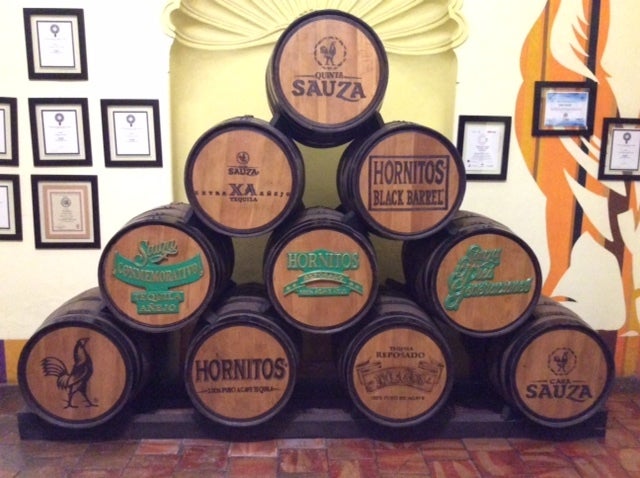
The Casa Sauza’s family of tequila brands.
Currently Sauza produces four distinct families of tequilas: Sauza, Conmemorativo, Hornitos and Tres Generaciones. In addition, Sauza also produces a range of flavored tequilas under both the Sauza and Hornitos brands.
Sauza Tequila
- Sauza Blanco – double distilled, unaged (mix of agave and non-agave sugars)
- Sauza Extra Gold – double distilled, unaged 40% ABV (mix of agave and non-agave sugars)
- Sauza Signature Blue Silver - 100% agave, double distilled, unaged
- Sauza Signature Blue Reposado - 100% agave, double distilled, rested in oak casks
Conmemorativo
Sauza Conmemorativo (Añejo) - Since 2012, 100% agave. Aged 18 months in ex-bourbon casks
Hornitos
- Hornitos Plata - 100% blue agave, double distilled, unaged
- Hornitos Reposado - 100% blue agave, double distilled, rested two months in 10,000 gallon oak vats
- Hornitos Añejo - 100% blue agave, double distilled, aged at least 12 months in American oak barrels
- Hornitos Black Barrel - takes the standard Hornitos Añejo tequila aged for a year in traditional oak barrels and then finishes that tequila in heavily charred American oak casks for four months followed by two additional months in a toasted American oak barrel.
Tres Generaciones
- Tres Generaciones Plata - 100% blue agave, triple-distilled, unaged.
- Tres Generaciones Reposado - 100% blue agave, triple-distilled, aged at least four months in American oak barrels
- Tres Generaciones Añejo - 100% blue agave, triple-distilled, aged at least 12 months in toasted American oak barrels
Tasting notes on a selection of the Sauza range appear below.
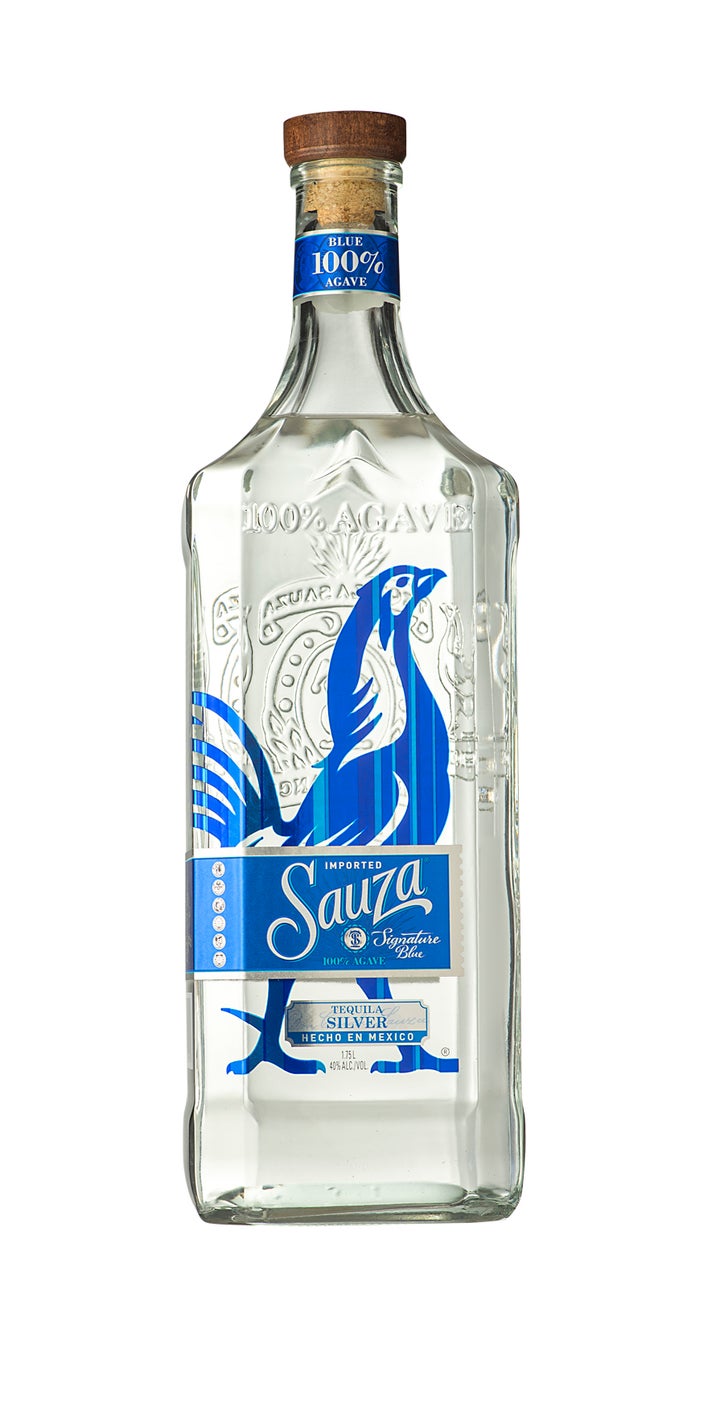
Sauza Signature Blue Silver
Sauza Signature Blue Silver, 40% ABV, 750 ml
Recently rebranded with a new name, packaging and bottle design, this is Sauza’s entry level 100% agave tequila. It is generally bottled immediately after distillation, but may be aged in wood for up to 30 days or held in a stainless-steel vat for up to 60 days. Colorless.
On the nose there is a subtle, herbal, earthy note of agave followed by notes of citrus, orange blossom and hints of white pepper. On the palate, the flavors are more pronounced but short lived, with notes of grapefruit, sweet fruit, and floral aromas followed by a distinct alcohol burn. The finish is crisp and short with a noticeable sweetness and slight agave notes that dissipate quickly. For an entry level 100% agave tequila intended for cocktails, it offers excellent value.
Appearance 8/10, Nose 24/30, Palate 25/30, Finish 24/30. Overall Score: 71/100
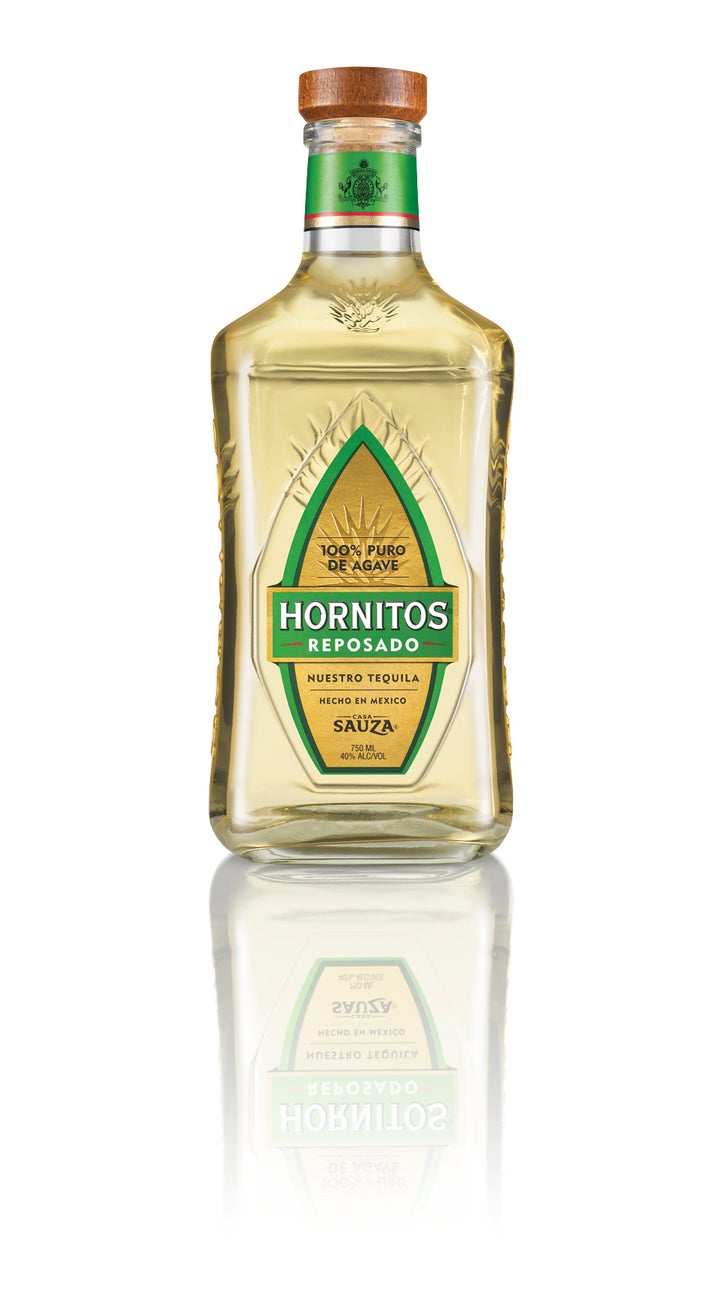
Hornitos Reposado
Hornitos Reposado Tequila, 40% ABV, 750 ml
This tequila has a light straw/gold color. After distillation, it was rested in 10,000 gallon oak vats called pipones for a period of anywhere from two months to as much as a year. It’s named for the stone ovens that traditionally have been used to cook the agave.
On the nose, there is a spicy note, less peppery and more tropical spice, cloves and a very slight hint of cinnamon. The agave notes are more pronounced with elements of sweetness, potpourri, and slight herbal, earthy and vegetal notes all framed against a light wood note.
On the palate, there is a noticeable sweet, creamy quality, with a heavier mouth weight than on the Signature Blue tequilas. There are sweet, fruity agave notes, a hint of green apple, set against subtler vegetal and cilantro/herbal notes.
The finish is medium length, with some pepper and bitter elements that steadily build, a bit of alcohol burn and a sweet fruity note that lingers on the palate.
Appearance: 7/10, Nose 25/30, Palate 25/30, Finish 26/30. Overall Score: 83/100
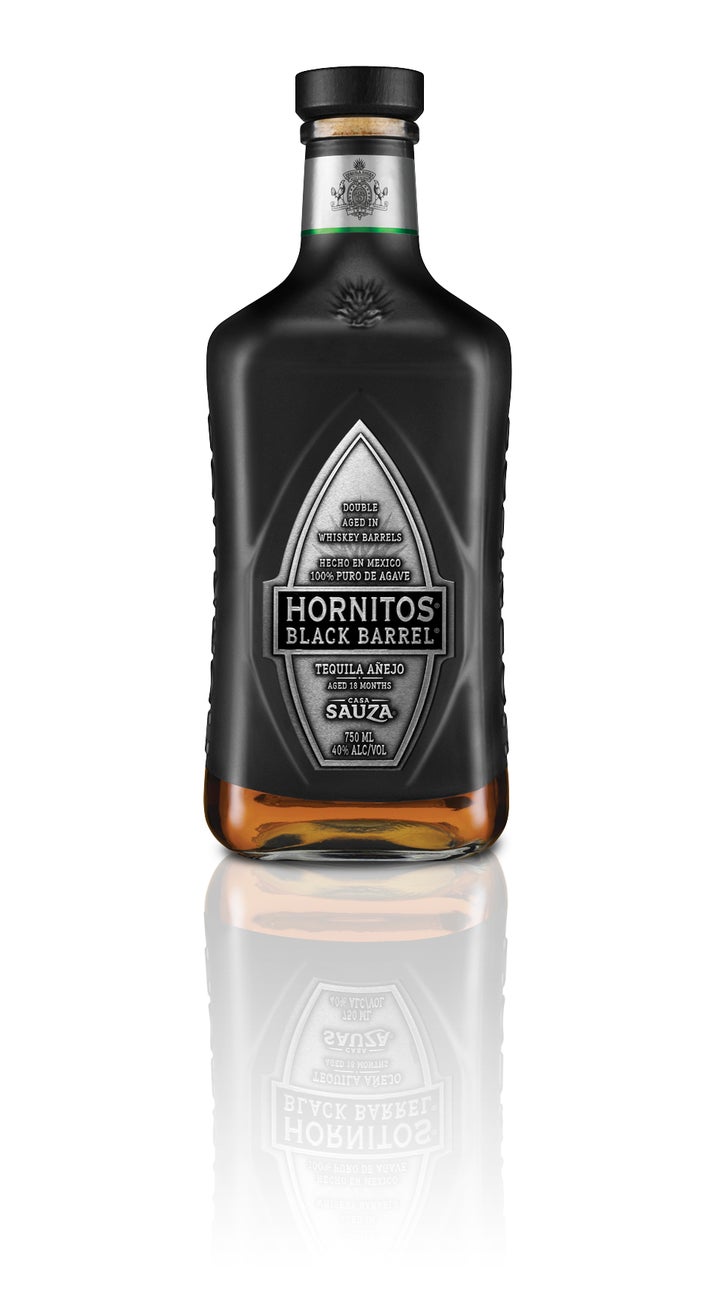
Hornitos Black Barrel
Hornitos Black Barrel Tequila, 40% ABV, 750 ml
Black Barrel is an añejo tequila that is aged in oak barrels, usually ex-bourbon, for a period of 12 months. It then receives an additional four months of aging in deeply charred, typically a number five to number seven char, barrels followed by a final two months in specially toasted American oak barrels. Black Barrel is packaged in a black bottle with a distinctive black matte finish.
The result is an añejo like tequila with a more pronounced wood influence; something in-between a traditional tequila and a whiskey, that is still true to its agave roots.
The color is a deep amber color. On the nose, there is a distinctive wood spice influence, vanilla, cinnamon and some clove notes followed by some floral elements and some wood/cigar box notes. There are the typical agave herbal and vegetal notes in the background, but these are subtler. They become more noticeable with a bit of water.
On the palate there is sweetness, caramel notes and fruit, more dried than fresh, followed by herbal/vegetal notes and a hint of smokiness. The finish is long, smooth, with distinctive sweet caramel notes, vanilla, wood spice and a hint of bitterness that lingers.
This is a sipping tequila, although at the hand of a skilled mixologist it could craft some very interesting cocktails. This is a tequila for whiskey lovers; one that incorporates many of the aromas and flavors we associate with whiskey, but which still reveals, albeit subtly, its agave roots. In other words, if you shipped agave piñas to Tennessee and used them to make whiskey, this is what it would probably taste like.
Appearance: 9/10, Nose 27/30, Palate 26/30, Finish 27/30 Overall Score: 89/100

Sauza Tres Generaciones Anejo
Tres Generaciones Añejo Tequila, 40% ABV, 750 ml
Tres Generaciones is a triple distilled tequila. Like all Sauza tequilas it undergoes an initial distillation in a column still. It then receives two additional distillations in a pot still. It’s aged for a year, typically in ex-bourbon barrels. The result is an exceptional smooth tequila.
The color is a light straw color. On the nose there is distinctive caramel, vanilla sweetness, followed by classic agave herbal, vegetal and earthy aromas. There are light fruity notes of citrus and even a bit of tropical fruit in the background but these are overshadowed by the more vegetal aromas.
On the palate, there are creamy vanilla and caramel notes, with wood spice notes of cinnamon and nutmeg as well as a noticeable pepperiness. The vegetal and herbal notes remain in the background throughout. The finish is medium length with sweet notes followed by pepperiness and herbal/vegetal notes with a lingering smokiness.
Appearance: 8/10, Nose: 26/30, Palate 26/30, Finish 25/30 Overall Score: 85/100
Sauza is one of the grand names in the storied history of Jalisco and its tequila. Now well into its second century, it continues to shape the tequila industry and remains at the forefront of its innovation. Salud!
